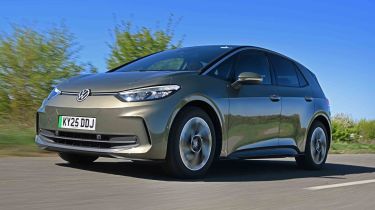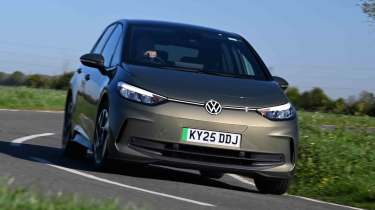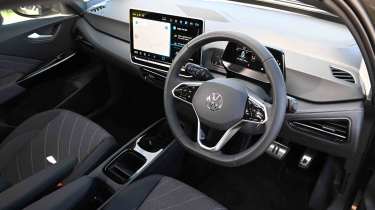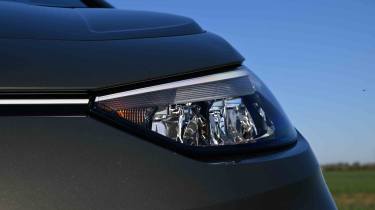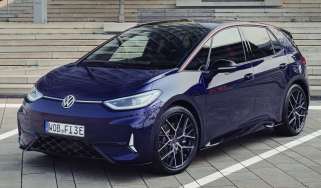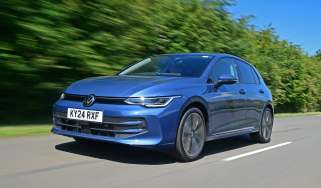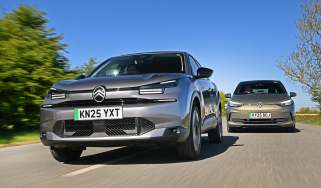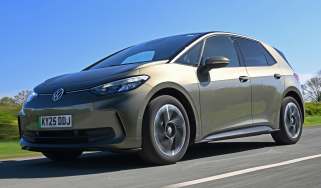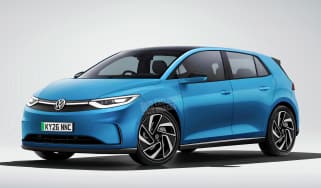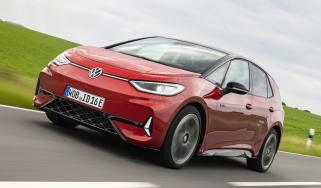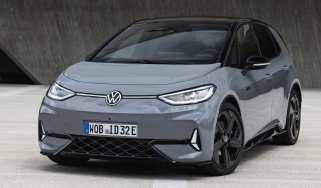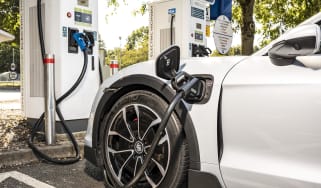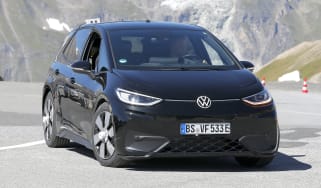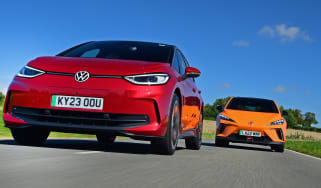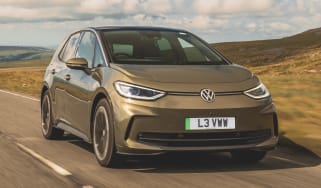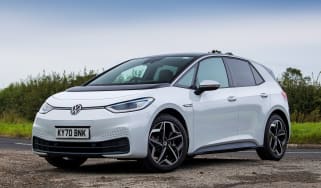Volkswagen ID.3 review
The Volkswagen ID.3 is a good electric hatchback overall, but a few niggles hold it back

Our opinion on the Volkswagen ID.3
Think of the Volkswagen ID.3 as an electric Golf, and you won’t be too far off the mark. It certainly has the traits of VW’s ubiquitous hatchback, and a lot of the tech on board will be familiar to modern Golf drivers, while its all-electric powertrain and dedicated EV platform deliver a good driving range and composed performance. Practicality is strong, despite the car’s size, while an early facelift helped to rectify some of our criticisms at launch. There are still quirks in the infotainment system that take some getting used to, though, and higher-spec models look expensive when compared with rivals.
About the Volkswagen ID.3
When it was first launched, the Volkswagen ID.3 was tasked with attracting buyers to electrification, with the hope that they might ultimately hold it in the same esteem as its classic Beetle and Golf name plates. Things haven’t panned out that way so far, but the ID.3 was the first of a wave of electric ID models from the brand that now cover a number of classes.
An early update in 2023 fixed some of our initial concerns with the ID.3, with softer materials added to the cabin, a revamped exterior design and updated infotainment tech. However, the ID.3 still struggles to be a defining model in the electric hatchback sector.
Used - available now

2026 Audi
Q2
35,539 milesAutomaticPetrol1.5L
Cash £21,495
2017 Mazda
CX-5
89,646 milesAutomaticDiesel2.2L
Cash £10,499
2020 Audi
Q5
91,464 milesAutomaticPetrol2.0L
Cash £19,995
2017 Ford
Focus ST
121,000 milesManualDiesel2.0L
Cash £6,995Electric family cars are rapidly becoming some of the biggest sellers on Britain’s roads, so we’ve put the ID.3 through a wide range of testing since it first arrived. In order to get a full taste of what VW’s electric hatch is like to live with, we spent six months with an ID.3 Pro S as part of our long-term test fleet, where it acted as our senior sub-editor’s first foray into the world of electric cars. The ID.3 also managed to defeat a French foe, the Citroen e-C4, in our budget-friendly family car twin test. The VW won thanks to its superior value for money and overall practicality.
Volkswagen ID.3 prices and latest deals
Pricing for the Volkswagen ID.3 starts from around £35,700 for the base model in Pro Essential trim. There are six trim levels to choose from in total, and these can push the starting price all the way up to almost £48,400 for the range-topping GTX Fire & Ice.
It’s worth noting that the ID.3 qualifies for band 2 of the Government's Electric Car Grant (ECG), which equates to a £1,500 discount that’s applied automatically when you purchase the car.
Of course, if you’d like to save even more than that, you can get an average of £2,800 off when you configure your perfect Volkswagen ID.3 through the Auto Express Buy a Car service. Alternatively, you can also find plenty of hot Volkswagen ID.3 leasing deals or search for a used Volkswagen ID.3. You can even sell your existing car for a great price with Auto Express Sell My Car.
Performance & driving experience
Pros |
|
Cons |
|
In a way, the VW ID.3 harks back to the classic Beetle with its rear-motor, rear-wheel-drive layout, although the modern underpinnings place everything within the car’s wheelbase, so there’s no risk of snap oversteer if you’re heavy with the throttle. Every variant has a single electric motor, and the rear-drive layout is designed for packaging rather than driving fun, but it does have a bearing on the ID.3’s behaviour.
| Model | Power | 0-62mph | Top speed |
| ID.3 Match Pro 59kWh | 201bhp | 7.6 seconds | 99mph |
| ID.3 Match Pro S 79kWh | 201bhp | 8.2 seconds | 99mph |
| ID.3 GTX 79kWh | 322bhp | 5.7 seconds | 124mph |
Performance, 0-60mph acceleration and top speed
While every ID.3 is rear-wheel drive, there’s still a fair bit of performance variation, which ultimately depends on your chosen specification.
The lower spec Pro Match and Pro Essential cars are fitted with a 59kWh battery, and both produce 201bhp and 265Nm of torque from their rear-mounted motors. This results in a 0-62mph time of 7.6 seconds, which is ever so slightly quicker than the equivalent MG4 (7.7 seconds).
In the middle of the line-up sits the Pro S, which is also available in Match or Essential trim. This carries a larger (and heavier) battery while producing the same 201bhp, meaning a slower 8.2 second 0-62mph time. In other words, the key advantage here is battery range rather than performance.
At the top of the range you’ll find the GTX, and this is the most powerful ID.3 with 322bhp and 545Nm on tap. This power boost slashes the 0-62mph time to a much livelier 5.7 seconds. Standard versions of the ID.3 are limited to 99mph, while the GTX has a top speed of 124mph.
Town driving, visibility and parking
While other rear-drive models take advantage of their lack of driveshifts up front to provide a tight turning circle, the ID.3 has a fairly conventional 11.5 metre turning radius. In comparison, the MG4’s radius sits between 10.6 and 11.7 metres, depending on spec. The VW’s steering wheel is light at low speeds, though, and the responsive chassis means the car is easy to manoeuvre. All models come with front and rear parking sensors for added peace of mind, although a rear camera is only standard on Match trim cars and above.
Even the low-powered ID.3 is responsive, while the throttle is easily controlled. One quibble we have is with the ride, which can feel unsettled at lower speeds. It’s not enough to be considered uncomfortable, though.
Country road driving and handling
At higher speeds the ID.3’s ride improves, while a lack of wind and road noise means refinement is decent and the car offers a good balance between ride comfort and body control. It’s not exactly what you’d call fun, but the lighter weight of the small-battery Pure model helps the ID.3 feel relatively agile, and when accelerating hard out of a corner you can feel the rear-drive layout push the car gently without the risk of the tyres breaking traction.
Motorway driving and long-distance comfort
With 265Nm of torque on tap as soon as you press the accelerator, even the lowest-powered ID.3 has no trouble getting up to higher speeds. There’s still enough flexibility in the powertrain to help with overtaking, too, while the ride is smooth and the cabin remains hushed at higher speeds.
“You don’t really need a sub-10 second 0-60mph time from a family hatchback, so for that reason I’d happily stick with the newer Pure model. It still manages the sprint in a little over eight seconds, while weight savings of 35kg and 170kg over the Pro and Pro S versions boost the car’s agility.” – Dean Gibson, senior test editor.
Range, charging & running costs
The combination of the Pure battery and Essential trim has helped reduce the starting price of the ID.3, while everyday running costs should be reasonable, too.
Electric range, battery life and charge time
With the smaller 59kWh battery on board, the ID.3 has an official WLTP combined range of up to 269 miles. In comparison, the MG4 claims up to 288 miles with its 64kWh long-range battery, and the Citroen e-C4 officially manages 257 miles from its largest 54kWh pack, so the VW is reasonably competitive.
When we tested the Pure model in Match trim we saw an average of 4.1 miles per kWh, which was pretty good considering the number of motorway miles that were covered – the car’s slippery shape helps in this regard. That translated into a range of 213 miles, which was some way short of the official claim, but still a decent enough range for most everyday needs.
The larger 79kWh Pro S claims up to 352 miles from a full charge, while the most powerful GTX bumps this up even further to 371 miles. A common rule of thumb with EVs is that more power means reduced battery range, so the GTX is quite unique in this regard. However, the Cupra Born VZ shares the same platform and battery as the ID.3 GTX, and this manages up to 369 miles while providing very similar driving thrills.
Maximum charging rates for the ID.3 vary according to battery size. The 59kWh pack has a top rate of 165kW DC, while the Pro S and GTX manage 185kW. The net result is that a capable rapid charger will take each pack from 10 to 80 per cent capacity in 24 to 26 minutes.
When it comes to topping up at home, a typical 7.4kW home wallbox will fully replenish the ID.3’s 59kWh battery in just over nine hours, creeping up to roughly 12 hours for the 79kWh pack
No ID.3 comes with a heat pump as standard. If you want to add one to help maintain range in cold weather, it’ll cost you more than £1,000. We think this is rather tightfisted, as the Renault Megane E-Tech and Vauxhall Astra Electric have this included in every model.
| Model | Battery size | Range | Insurance group |
| ID.3 Match Pro 59kWh | 59kWh | 268 miles | 26 |
| ID.3 Match Pro S 79kWh | 79kWh | 350 miles | 29 |
| ID.3 GTX 79kWh | 79kWh | 371 miles | 34 |
Insurance groups
Group ratings for the ID.3 align with the powertrains offered, and these range from group 26 (out of 50) for the Pro, all the way up to group 34 for the GTX. The MG4, meanwhile, sits between groups 27 and 40, while the Renault Megane E-Tech finds itself in groups 25 and 27. Don’t forget, though, that while the ID.3 and MG4 have fiery performance variants, the Renault does not, hence its lower maximum insurance rating.
Tax
With a three per cent Benefit-in-Kind rate for electric vehicles, company car tax rates will boil down to list prices, so the entry-point Pure versions of the ID.3 will be the very best for business users.
While it's only the GTX that finds itself north of the £40,000 mark in standard guise, every ID.3 can quickly leap into luxury car tax territory if you’re a bit too liberal with the options list. Surpass this amount and you’ll find yourself paying a total of £620 in VED road tax between years two and six after the car’s first registration.
Depreciation
As with a number of electric cars, depreciation takes a pretty significant toll on the Volkswagen ID.3. Our expert data suggest that VW’s electric hatch will only manage to cling on to between 38 and 47 per cent of its initial value after a period of three years or 36,000 miles.
The Renault Megane E-tech puts on a slightly better performance after the same amount of time, retaining 45 to 49 per cent, but the VW’s sister car, the Cupra Born, only manages to scrape together 41 to 44 per cent.
To get an accurate valuation for a specific model, check out our free car valuation tool...
Interior, design & technology
Pros |
|
Cons |
|
When it was unveiled in 2019, the Volkswagen ID.3 had a friendly face, but the brand decided to give it a more aggressive look as part of a mid-life facelift back in 2023. To achieve this, the ID.3 received a new front bumper, and the black panel at the base of the windscreen was removed, which makes the bonnet look longer and better proportioned. Tweaks to the rear included revised tail-lights with an X motif when illuminated. Overall, the changes were relatively subtle, but they helped to give the ID.3 slightly more kerb appeal.
Interior and dashboard design
The minimalist interior of the ID.3 has been a source of constant criticism since the car launched, with the cheap-feeling materials, infuriating touch-sensitive climate controls and fiddly infotainment system bringing the car down. However, the mid-life update brought improved quality, with softer plastics and textured trim helping to give the cabin a much-needed lift.
Materials and build quality
VW’s facelifting efforts definitely boosted the ID.3’s appeal and the air of quality inside. Base models come with cloth upholstery as standard, but a two-tone finish and wave-like stitching help to break up the monotone looks inside, while the soft dashboard with stitched edges also adds to the more upmarket ambience. One glaring omission that would give the ID.3 a boost (and makes the Golf feel like a quality product) is flock-lined door bins – in basic models they’re just bare plastic, so loose items rattle around.
Infotainment, sat-nav and stereo
The ID.3 was also given a tech boost as part of its revamp, with all models now featuring a 12.9-inch screen, although the amount of functionality it has depends on the trim level chosen, with Discover Pro navigation only standard with Match trim and above. Permanent climate controls are situated along the bottom of the display. Thanks to the screen’s size, they’re easy to use when you’re on the move.
The built-in software works reasonably well, with smart routing for sat nav-equipped cars (you can ‘unlock’ navigation on lower-spec models by paying extra for it via the screen), but some of the sub menus seem showy for no real reason – we’d like a simpler looking set-up.
Connectivity includes four USB-C sockets in the cabin, which are all mounted on the central armrest – two between the front seats and a pair at the back for rear occupants.
One oddity that still remains in the ID.3 is the dual-function window switches on the driver’s door: instead of having four controls, there are only two, plus a button that switches between front and rear. It seems like a solution to a question that has never been asked.
“I think Match trim adds enough extra to the ID.3 to justify its mark-up over the Essential version. Alloy wheels look smarter than the plastic trims on the base spec, while the reversing camera, navigation and main beam assist are all useful features to have.” – Dean Gibson, senior test editor.
Boot space & practicality
Pros |
|
Cons |
|
The five-door ID.3 is easy to get in and out of, and once you’re sitting in the cabin, you’ll immediately notice the extra space compared with the current Volkswagen Golf. Comfortable seats with standard armrests make it a relaxing place to spend time in, while the pared-back interior contributes to the feeling of space. Visibility is generally good, although, much like the Cupra Born, the chunky front pillars can be awkward to look around at tight junctions.
Dimensions and size
The Volkswagen ID.3 is a bit shorter than the Mk8 Golf, but slightly wider and taller. The MG4 is slightly larger overall, but only just, while the ID.3’s sister car, the Cupra Born, is longer and lower than the VW. If you’d like a more SUV-style look, then the Citroen e-C4 is more of a high-riding hatchback/crossover, but offers a similar amount of space inside to the ID.3.
Dimensions comparison | |||
| Model | Volkswagen ID.3 | MG4 | Renault Megane E-Tech |
| Length | 4,264mm | 4,287mm | 4,200mm |
| Width | 1,809mm | 1,836mm | 1,860mm |
| Height | 1,568mm | 1,516mm | 1,505mm |
| Wheelbase | 2,770mm | 2,710mm | 2,690mm |
| Boot space | 385 litres | 289 litres | 440 litres |
Seats & passenger space
There’s a wide range of wheel and seat adjustment, and the compact instrument cluster ahead of the driver moves with the steering wheel, so is always in line of sight.
Storage is fine, with slender door bins, two open cup holders, slot and cargo net storage for smartphones, and a tray between the front seats with a sliding cover, while there are individual armrests for the front seats. The glovebox is frustratingly narrow, though, due to the location of fuses – it’s an unusual quirk to find in a VW, as usually this set-up is reserved for models from French car makers.
At launch the ID.3 came in four or five-seat configurations, but today all models have three seatbelts in the back. Space is fine, although it feels a little narrow when travelling three up, while there’s enough room for feet courtesy of the flat floor and plenty of space under the front seats. The middle seat folds down to reveal two cup holders, while there’s a ski hatch in the seat back for longer items.
Boot space
The ID.3 has a 385 litre boot with the rear seats in place, which is four litres larger than a Mk8 Golf, but the Renault Megane E-Tech offers even more capacity at 440 litres. There’s no additional storage under the ID.3’s bonnet, but a false boot floor is optional on lower-spec cars and standard further up the range, and this lets you tidily stow away the charging cables. It also creates a level loading area when the back seats are folded. With the false floor removed and the rear seats down, the ID.3 has 1,601 litres of space.
“Towing isn’t an option with the ID.3, although Volkswagen does offer a tow hitch preparation as an optional extra. This is so you can fit a cycle carrier to the back of the car.” – Dean Gibson, senior test editor.
Reliability & safety
Pros |
|
Cons |
|
The ID.3 was awarded a five-star crash safety rating by Euro NCAP in 2020, and it managed to retain this maximum score when it was tested under revised and much stronger criteria in 2025.
Standard safety kit includes a driver fatigue alert system, dynamic traffic sign display, lane-keeping assist, adaptive cruise control, parking sensors front and rear, and autonomous emergency braking (AEB) with cyclist and pedestrian monitoring. As with all electric cars, the ID.3 emits an artificial noise at low speeds to warn cyclists and pedestrians of its presence.
More driver-assistance tech is available on the options list. The Assistance Package Plus (£2,240) adds an area-view camera set-up, lane change assist and Volkswagen’s semi-autonomous Travel Assist system. Adding one of the Interior Comfort Packs (£2,325 or £3,865 for the Top Sport Plus package) can also get an augmented-reality head-up display.
Volkswagen provides a three-year/60,000-mile warranty, while the ID.3’s battery is covered for eight years or 100,000 miles. All VW EVs also come with three years of roadside assistance.
The ID.3’s servicing schedule commences after two years, irrespective of the mileage covered, and from this point it’s recommended that servicing takes place every year or 20,000 miles.
| Euro NCAP safety ratings | |
| Euro NCAP safety rating | Five stars (2020 & 2025) |
| Adult occupant protection |
86% (2025) 87% (2020) |
| Child occupant protection |
87% (2025) 89% (2020) |
| Vulnerable road user protection |
78% (2025) 71% (2020) |
| Safety assist |
76% (2025) 88% (2020) |
Buying and owning
- Best buy: Volkswagen ID.3 Pure Match
The entry-level ID.3 offers the best value in our eyes. It comes with plenty of standard kit, while the 59kWh battery delivers good efficiency and range when compared with other electric hatchbacks at a similar price point.
Volkswagen ID.3 alternatives
The most direct relation to the VW ID.3 is the Cupra Born, which is largely the same car but with a sportier set-up and arguably sharper looks. At the value-driven end of the electric car world, you could consider the Citroen e-C4, MG4 or possibly even the Renault 4, which is a similar size. Other options include the Renault Megane E-Tech and Hyundai Kona Electric, while the Peugeot 308 and Vauxhall Astra offer either electric or combustion engine options.
If petrol is more to your liking, then of course there are conventional five-door hatchbacks such as the Volkswagen Golf, as well as efficient hybrids like the Toyota Corolla and Honda Civic.
Volkswagen ID.3 Pro S long-term test

Our chief sub-editor, Andy Pringle, spent six months with the Volkswagen ID.3 as part of our long-term fleet. It was the first time he’s had the keys to an all-electric car, and he was left feeling very impressed with how simple the VW is to drive. The smooth and refined powertrain makes it the perfect urban runabout for him and his family, and he’s convinced that it’d make a great starting point for any EV newbies.
However, despite improvements to the much-maligned infotainment system, Andy still felt that it was far from perfect, and quickly became frustrated with how long it took to complete simple actions. You can read the full long term test here…
Frequently Asked Questions
While it’s not the genre-defining model that Volkswagen had hoped for, the ID.3 is still a decent electric family hatchback. There are rivals that do things a bit better, though, and prices can get steep at the top of the range. We’d keep things simple with the Pure model in Match trim to help keep costs down.
Deals on the ID.3 and alternatives
